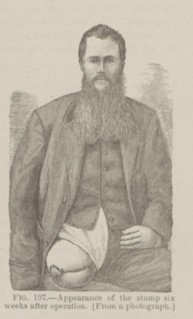Title: Jones, Jesse M.
Source text: The Medical and Surgical History of the War of the Rebellion. (1861-65.), Part 3, Volume 2 (Washington, DC: Government Printing Office, 1883), 305.
Civil War Washington ID: med.d2e13266
TEI/XML: med.d2e13266.xml
CASE 476.—Private Jesse M. Jones, ¹ Co. K, 21st Indiana, aged 29 years, was wounded at Baton Rouge, August 5, 1862, by a musket ball, which fractured the right femur at the junction of the middle and upper thirds. He was taken to the regimental hospital, remained there one day, and was then sent on a hospital transport to New Orleans, the limb meanwhile being supported by bandages and pillows. On arrival, August 7th, he was admitted to the St. James Hospital, where a long splint was applied, seventeen days after the reception of the wound. He was discharged April 15, 1863, and pensioned. On November 14, 1866, Examining Surgeon W. J. Hoadley, of Danville, Indiana, reports: "The wound still unhealed, fracture had united by large deposits of bone; limb shortened four and three-fourths inches." In January, 1869, he entered Providence Hospital, Washington; and, on the 23d, Dr. D. W. Bliss, late Surgeon U. S. V., amputated the thigh in the upper third by the antero-posteriorflap method. The pathological specimen was presented to the Army Medical Museum by the operator. It is No. 5558 of the Surgical Section (FIG. 196), and shows great deformity, with exfoliations on posterior aspect, and a fragment of lead imbedded in the callus. On March 9, 1869, Jones visited the Museum, when his photograph (A. M. M. Card Photographs, Vol. I, p. 27) was taken, a copy of which is shown in the wood-cut (FIG. 197). His pension was paid December 4, 1879.
¹ An account of the case has been published in Circular No. 3, Surgeon General's Office, Washington, 1871, p. 209.

